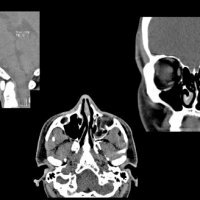Tomography of the sinuses of the nose

( CT) Computer tomography of the nasal sinuses is a computer-mathematical model of the frontal and maxillary sinuses of the nose, obtained through x-ray irradiation. Today in otorhinolaryngology, this is the most accurate diagnosis, which makes it possible to obtain the most correct data on the state of the sinuses of the nose and surrounding structures. With its help, you can visually see the amount of fluid in the sinuses, create a multilayer three-dimensional picture and look at the sinuses in different planes. CT sinus is necessary in case of trauma of the facial bone in order to get an idea of the abnormalities, inflammatory processes and anomalies in the frontal and nasal sinuses.
Indications for a sinus scan of the sinuses of the nose
Reconstruction of the sinuses of the nose is necessary in many cases, often it is the only way to pre-determine the developing disease:
- in cases of complex diagnosis, when the symptoms can not reveal the complete picture;
- for chronic inflammatory processes in the sinuses of the nose, hampering treatment;
- in the treatment of complex forms of sinusitis;
- sinusitis;
- with purulent dacryriocystitis - lesion of lacrimal ducts;
- tomography is necessary when detecting cysts, polyps or tumors in the sinuses of the nose.
- For prolonged dental and headaches, in the case of painful pressure on the eyeballs. This may reveal in advance the aveolar cyst or the inflammation of the frontal sinuses.
Opportunities and advantages of CT in front of the
- as an opportunity to obtain sections of the sinuses of the nose, ducts and tissues in various projections;
- obtaining a clear and intuitive picture of sinus walls, density, mineralization;
- accuracy of sinus condition evaluation, it is possible to determine the degree of curvature of the septum;
- CT allows the diagnosis of genyantritis, sphenoditis, sinusitis and frontalitis, while X-rays are not capable of diagnosis;
- has the ability to distinguish between malignant tumors and benign tumors;
- it is worth noting that CT can identify complications, orbital and cranial abscesses.
Such accurate data allows you to get the most accurate data, put the right diagnosis and avoid unnecessary surgical interventions and injuries.
Conduction of CT of the sinuses of the nose
Tomography of the sinuses is made in a horizontal position on a special table. The head is fixed to avoid accidental movements, in the presence of severe pain and neurosis it is necessary. Sometimes, for a clearer picture, a special color liquid is injected intravenously. In the process of preparation, the patient only needs to lie still and allow the doctor to adjust the device to the desired mode of research. A person in a tomographic capsule has the opportunity to communicate with a doctor through a speakerphone. The table in the capsule constantly moves along the specified path program, the light ring of the tomograph makes circular motions and fixes all the data. The procedure is absolutely painless and without any sensations, CT is many times safer than a standard X-ray machine.
CT for children
Research on the scanner has limitations for children, the procedure allows children from the age of 14 years, in case there are problems with immobility, sedatives are used. Age is due to the complexity of the process and a small amount of radiation.
Contraindications to the CT of sinuses
- Unequivocally CT is contraindicated in pregnancy, this is due to the presence of a small dose of radiation, which can affect the development of the fetus.
- Weight category, these are very rare cases, but the CT table is designed for a weight not exceeding 200 kg.
There may be special reasons for the impossibility of performing tomography:
- if a person can not tolerate iodine, which is part of the contrast medium, this results in severe allergies and a stopping of the examination;
- for various kidney diseases: with kidney failure and the presence of pathologies, this makes it difficult to remove fluid and leads to toxicity and allergy;
- breastfeeding mothers for 2 days can not feed children, because the dye solution is distributed throughout the body, including gets into milk;
- a special approach requires patients with severe injuries, in shock or in coma. This procedure is quite lengthy and requires a personal sensation of the person. In the cases listed above, consent of relatives is required, collection of additional analyzes for allergies and general condition, and constant monitoring throughout the process.



